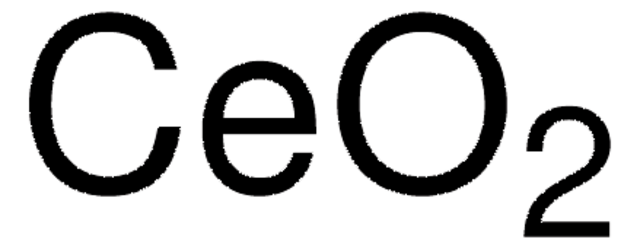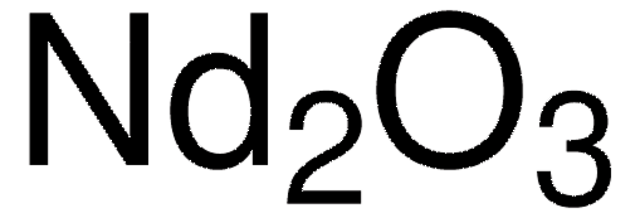모든 사진(2)
About This Item
Linear Formula:
Gd2O3
CAS Number:
Molecular Weight:
362.50
EC Number:
MDL number:
UNSPSC 코드:
12352303
eCl@ss:
38161003
PubChem Substance ID:
NACRES:
NA.23
추천 제품
분석
≥99.99% trace metals basis
양식
powder
반응 적합성
reagent type: catalyst
core: gadolinium
mp
2330 °C (lit.)
density
7.407 g/mL at 20 °C (lit.)
SMILES string
O=[Gd]O[Gd]=O
InChI
1S/2Gd.3O
InChI key
RNYFGGMJZRTZKO-UHFFFAOYSA-N
유사한 제품을 찾으십니까? 방문 제품 비교 안내
신호어
Warning
유해 및 위험 성명서
예방조치 성명서
Hazard Classifications
Eye Irrit. 2
Storage Class Code
11 - Combustible Solids
WGK
WGK 1
Flash Point (°F)
Not applicable
Flash Point (°C)
Not applicable
개인 보호 장비
Eyeshields, Gloves, type N95 (US)
이미 열람한 고객
Zijian Zhou et al.
Advanced materials (Deerfield Beach, Fla.), 24(46), 6223-6228 (2012-09-14)
Monodisperse Gd(2) O(3) -embedded iron oxide (GdIO) nanoparticles can simultaneously enhance the local magnetic field intensities of each other under an external magnetic field and result in synergistic enhancement of T(1) and T(2) effects. GdIO nanoparticles have the unique property
Eva Hemmer et al.
Acta biomaterialia, 9(1), 4734-4743 (2012-09-12)
Bioimaging is an important diagnostic tool in the investigation and visualization of biological phenomena in cells and in medicine. In this context, up-converting Gd(2)O(3):Er(3+),Yb(3+) nanostructures (nanoparticles, nanorods) have been synthesized by precipitation methods and hydrothermal synthesis. Independent of size and
Aamir D Abid et al.
Particle and fibre toxicology, 10, 1-1 (2013-01-12)
The deposition, clearance and translocation of europium-doped gadolinium oxide nanoparticles in a mouse lung were investigated experimentally. Nanoparticles were synthesized by spray flame pyrolysis. The particle size, crystallinity and surface properties were characterized. Following instillation, the concentrations of particles in
Yu Kimura et al.
Advanced healthcare materials, 1(5), 657-660 (2012-11-28)
The synthesis, characterization, and functional evaluation of new size-controlled and biocompatible Gd(2) O(3) nanoparticles as a bimodal contrast agent for use in photoacoustic (PA) and magnetic resonance (MR) imaging are reported. These nanoparticles show a clear PA image by themselves
Andrée-Anne Guay-Bégin et al.
Langmuir : the ACS journal of surfaces and colloids, 28(1), 774-782 (2011-10-06)
The performance of nanomaterials for biomedical applications is highly dependent on the nature and the quality of surface coatings. In particular, the development of functionalized nanoparticles for magnetic resonance imaging (MRI) requires the grafting of hydrophilic, nonimmunogenic, and biocompatible polymers
문서
Rechargeable solid-state batteries are becoming increasingly important due to wide-spread use in computers, portable electronics, and vehicular applications.
자사의 과학자팀은 생명 과학, 재료 과학, 화학 합성, 크로마토그래피, 분석 및 기타 많은 영역을 포함한 모든 과학 분야에 경험이 있습니다..
고객지원팀으로 연락바랍니다.









